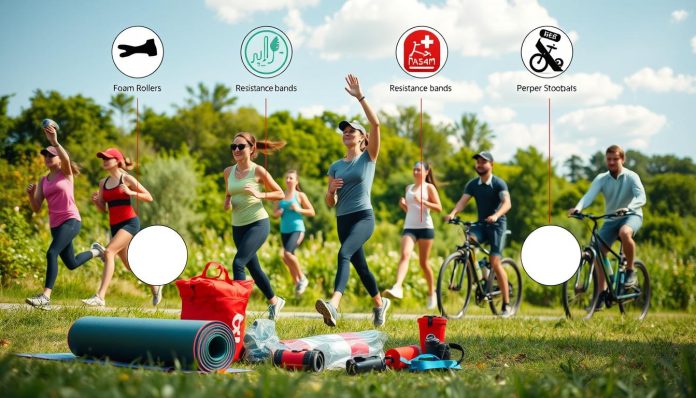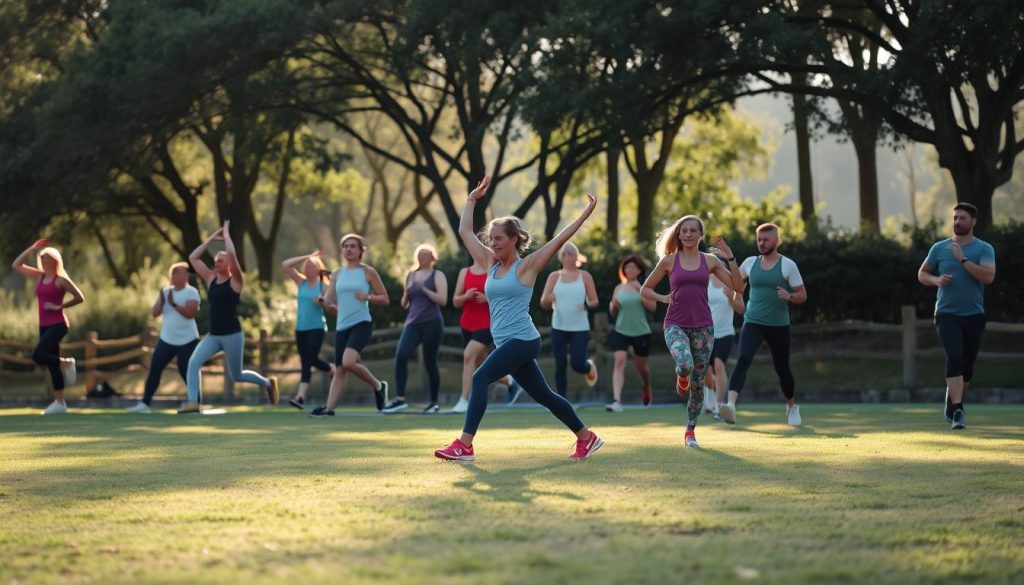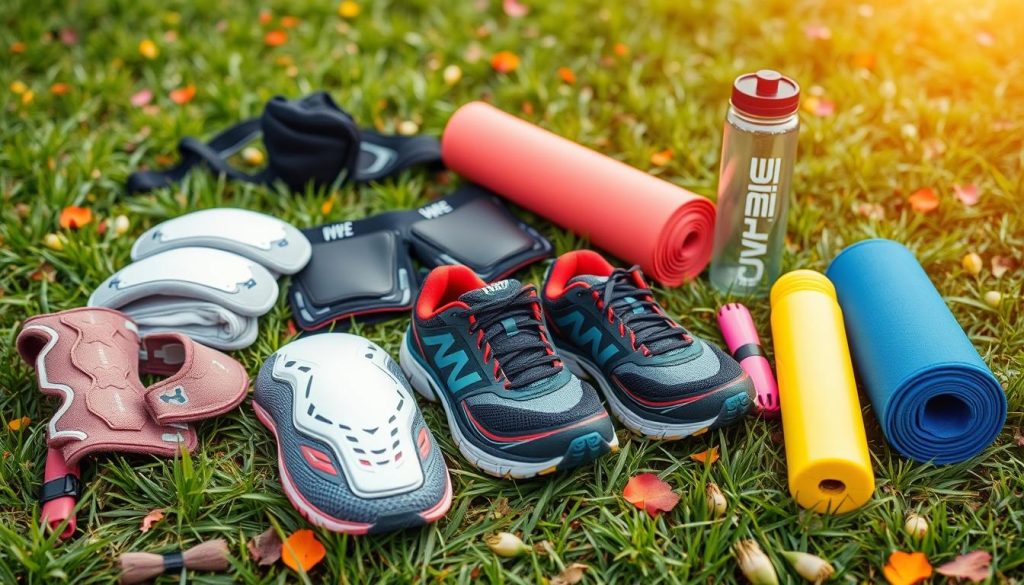When you’re active, it’s key to focus on injury prevention. This ensures you can stay healthy and active for a long time. By following these tips, you can keep exercising regularly and reach your fitness goals.
Understanding injury prevention is vital. By adding effective strategies to your daily routine, you can lower your injury risk. This guide offers insights and tips on preventing injuries. It covers warm-ups, cool-downs, proper technique, and the need for recovery time.
Introduction to Injury Prevention
Being active boosts your health and well-being. But, it’s important to prevent injuries to enjoy a long, healthy active life. By following these tips, you can lower your injury risk and enjoy the benefits of regular exercise.
Key Takeaways
- Learning how to prevent injuries is essential for staying active longer
- Incorporating injury prevention tips into your daily routine can minimize your risk of injury
- Staying active is vital for a healthy lifestyle
- Understanding the importance of recovery time is vital for injury prevention
- Proper technique and form are essential for reducing your risk of injury
- Warm-up and cool-down techniques can help prevent injuries and improve overall performance
Understand Your Body’s Signals
To keep your fitness going strong and avoid injuries, listen to your body. Recognize early signs of injury. This way, you can prevent injuries and stay active for longer. Knowing your limits and taking breaks to rest is key to injury prevention strategies.
It’s easy to get too excited and push too hard when you’re active. But this can lead to injuries. Paying attention to pain or discomfort helps prevent injuries. You might need to change your workout or add recovery steps like stretching.
Focus on avoiding injuries and taking care of your body. This means being aware of your body’s signals and resting when needed. It’s vital for fitness longevity. By using injury prevention strategies daily, you can stay healthy and active for years.
Watch out for signs of overdoing it, like feeling tired, dizzy, or sore. If you notice these, stop and rest. Don’t push yourself too hard. By listening to your body and preventing injuries, you can enjoy a healthy, active life. This includes better fitness longevity and overall health.
Warm-Up and Cool-Down Techniques
To keep an active lifestyle, warm-up and cool-down techniques are key. They help prevent injuries and keep you injury-free. This way, you can enjoy your favorite activities safely.
A good warm-up is essential for staying injury-free. It gets your muscles ready for exercise, boosting blood flow and lowering muscle strain risk. A cool-down, on the other hand, aids in recovery from hard workouts. It prevents dizziness and muscle soreness. Adding these to your daily routine keeps you healthy and active.
Dynamic Warm-Up Exercises
Dynamic warm-up exercises are great for getting your body ready for activity. Leg swings and arm circles increase blood flow and flexibility, cutting down injury risk. By doing these exercises, you’ll perform better and stay injury-free.
Effective Cool-Down Practices
Cool-down practices are just as vital as warm-ups. They help your body recover from hard exercise, easing muscle soreness and preventing dizziness. Using active lifestyle tips like static stretches and foam rolling in your cool-down routine keeps you healthy and balanced.
Focus on Proper Technique and Form
When you’re active, always focus on the right technique and form. This helps prevent injuries and keeps you fit for longer. Injury prevention techniques are key to avoiding common mistakes that can hurt you.
Exercise isn’t just about moving. It’s about moving right. Injury prevention techniques help you build a strong base and lower injury risks. Good technique and form boost your performance and fitness longevity.
Understanding safe training and avoiding mistakes is critical. Paying attention to your technique and form keeps you injury-free and fit for years. Remember, proper technique and form are vital for injury prevention techniques and fitness.
Key Principles for Safe Training
Safe training principles help you avoid injuries and keep your technique right. Listen to your body, warm up, cool down, and don’t push too hard.
Common Mistakes to Avoid in Exercise
Don’t make mistakes like bad posture, skipping warm-ups, or pushing too hard. Knowing these mistakes and avoiding them keeps you safe and fit for longer.
Choose the Right Gear and Equipment
Choosing the right gear and equipment is key for injury prevention strategies. As you aim to stay active, picking the right gear is vital. It supports your activities and lowers injury risk. This ensures a safe and fun experience, for both pros and hobbyists.
Proper footwear is a must for any athletic or fitness routine. It offers support and cushioning to avoid sprains, strains, and stress fractures. Also, the right protective gear shields vulnerable spots like the head, knees, and elbows.
It’s also important to make sure your equipment is safe. Check your gear for wear and tear signs, and replace it when needed. Look for damaged cords, loose parts, and worn-out surfaces. These steps help avoid injuries and keep you on track with your fitness goals.
Importance of Footwear for Your Activity
Footwear is a big deal in injury prevention strategies. Pick shoes made for your activity, like running, hiking, or sports. They offer the right support and stability to prevent injuries and boost performance.
Selecting Appropriate Protective Gear
Protective gear, like helmets and pads, protects vulnerable areas. It’s important to choose gear that fits right and matches your activity. This way, you can lower injury risk and stay safe while staying active.
Cross-Training: A Multidimensional Approach
To stay active and avoid injuries, mix different activities into your routine. This is called cross-training. It combines various exercises and sports to boost fitness and performance. By using active lifestyle tips like cross-training, you can get better endurance, strength, and flexibility. This helps lower injury risks.
One key advantage of cross-training is it helps prevent injuries. It avoids overworking certain muscles and joints. For instance, runners can reduce joint stress by adding swimming or cycling to their routine.
Benefits of Incorporating Different Activities
Adding different activities to your routine brings many benefits. You’ll see better heart health, stronger muscles, and more flexibility. Cross-training also helps avoid getting stuck in a rut and prevents overuse injuries. This keeps you consistently active.
Suggested Cross-Training Exercises to Consider
Consider swimming, cycling, and strength training for cross-training. These can be added to your current routine for a balanced fitness plan. Always pay attention to your body and use injury prevention techniques for a safe workout.
Listen to Your Body: When to Rest
When you’re active, it’s key to listen to your body and know when to rest. Avoiding injuries is vital for a healthy, active life. By tuning into your body’s signals, you can dodge injuries and keep your fitness journey long-lasting. For more on preventing sports injuries, check out preventing sports injuries and start your path to safer, more effective workouts.
Spotting signs of fatigue is critical for knowing when to rest. Feeling tired or sore muscles? It might be time to take a break. Planned rest days are also key for recovery and rebuilding. Adding rest days to your routine can lower injury risk and boost performance.
Recognizing the Importance of Rest
Rest isn’t a sign of weakness; it’s a must for a balanced fitness plan. By listening to your body and taking breaks, you can avoid injuries and keep your fitness journey going strong. Remember, it’s smarter to take a day off than risk injury and be out for a long time.
Stay Hydrated and Maintain Nutrition
To stay injury-free and lead an active life, focus on hydration and nutrition. These are key to preventing injuries and boosting performance. Drinking enough water helps your body work better, lowering the chance of muscle problems and other injuries.
Importance of Hydration in Active Lifestyles
Drinking water is essential for athletes and those who are active. Even a little dehydration can make you tired, dizzy, and less effective. Staying hydrated keeps your energy up and helps avoid injuries. Drink at least eight glasses of water a day, more if you’re very active or in hot weather.
Nutritional Needs for Preventing Injuries
Eating a balanced diet is important for an active lifestyle. Proper nutrition helps your body fix and grow tissues, which lowers injury risk. Eat lots of fruits, veggies, whole grains, and lean proteins. If you need a specific diet plan, talk to a sports dietitian or nutritionist.
Gradual Progression: Avoiding Overtraining
As you keep going on your fitness path, remember to focus on injury prevention strategies for lasting fitness longevity. Slowly getting better is key. It lets your body adjust to new challenges and lowers the chance of overtraining. Setting smart goals and knowing you need to increase little by little helps you avoid overdoing it and getting hurt.
Setting realistic goals means looking at where you are now and slowly adding more to your workouts. This helps your body get used to the new stuff and cuts down injury risk.
Understanding Incremental Increases
Incremental increases are small, steady changes in your workouts. They help your body get stronger and adapt. This could mean lifting more, running farther, or doing harder workouts. Making these small steps lets you keep pushing yourself without the risk of injury.
Implementing Gradual Progression
To start gradual progression, set clear, reachable goals for yourself. Then, make a workout plan that gets harder and longer over time. Always listen to your body and take breaks when you need to. This lets your body recover and get ready for the next challenge. By focusing on slow progress and injury prevention strategies, you can enjoy a long, healthy fitness longevity.
Engaging in Regular Flexibility Training
Staying active means adding injury prevention to your routine. Flexibility training is key but often ignored. It boosts your range of motion, cuts down muscle soreness, and boosts performance.
Flexibility training prevents injuries by boosting blood flow and easing muscle tension. This keeps you active and healthy. It’s vital for everyone, not just athletes.
Adding stretching to your daily routine brings flexibility training’s benefits. You’ll see better posture, lower injury risk, and better overall health. Remember, flexibility is key to a healthy, active life.
Benefits of Stretching Before and After Workouts
Stretching before and after workouts prevents injuries and boosts flexibility. It reduces soreness, improves movement, and boosts performance. This keeps you active and healthy, making it a must for injury prevention.
Recommended Stretching Routines
Start with recommended stretching routines in your daily life. Leg swings, arm circles, and hip flexor stretches are good places to start. Prioritize flexibility and injury prevention to stay active and healthy.
Seek Professional Guidance When Necessary
Following the active lifestyle tips and injury prevention strategies in this article can help a lot. But sometimes, you might need professional help. A certified personal trainer or physical therapist can offer valuable insights and support. They can help you reach your fitness goals safely.
When to Consult a Trainer or Therapist
If you’re not sure about the right form or technique for exercises, seek help. Also, if you’re recovering from an injury, it’s best to get professional advice. They can assess your needs, find any imbalances, and create a fitness plan just for you.
Advantages of Personalized Fitness Plans
Working with a professional means you get a fitness plan made just for you. It’s based on your body, goals, and fitness level. This can prevent injuries and make youractive lifestyleeven better for the long term.
FAQ
How can I prevent injuries and stay active longer?
To avoid injuries and stay active, listen to your body. Warm up and cool down right. Use the right gear and try different activities.
Rest when needed, stay hydrated, and eat well. Gradually increase your workouts. Regular stretching helps too. Get help from experts when needed.
What are some common signs of overexertion and the importance of recovery time?
Signs of overdoing it include pain, tiredness, and feeling less good at what you do. Taking breaks is key to staying healthy and active.
How can I create an effective warm-up and cool-down routine?
Start with light jogging and bodyweight exercises. Then, do active stretches to get ready for your workout.
For cooling down, do gentle stretches and light aerobic moves. Also, practice deep breathing to help your body recover.
Why is proper technique and form important for injury prevention?
Keeping the right form during exercise lowers injury risk. Focus on staying aligned and controlling your movements. Avoid common mistakes like overreaching.
What kind of gear and equipment should I choose to stay injury-free?
Pick the right shoes for your activity. Wear protective gear if needed. Make sure your equipment is safe and in good shape.
How can cross-training benefit my overall fitness and injury prevention?
Mixing up your activities can prevent overuse injuries. It boosts your fitness and keeps workouts interesting. Try swimming, cycling, or yoga.
When should I rest and how do I identify signs of fatigue?
Pay attention to your body’s signals. Look for signs like poor performance, pain, and slow recovery. Rest days are important for your body to heal and avoid burnout.
Why is staying hydrated and maintaining proper nutrition important for injury prevention?
Drinking enough water and eating right helps your muscles and joints. It keeps your body working well and lowers injury risk.
How can I avoid overtraining and progress gradually?
Set achievable goals and increase your workout intensity slowly. Avoid sudden changes in your routine. Gradual progress helps avoid injuries and overtraining.
What are the benefits of regular flexibility training?
Stretching regularly improves your joints and muscles. It helps prevent injuries and supports an active lifestyle. Stretch before and after workouts for best results.
When should I seek professional guidance for injury prevention?
Get help from a trainer or physical therapist if you’ve had injuries before. They can guide you in creating a safe and effective workout plan.




